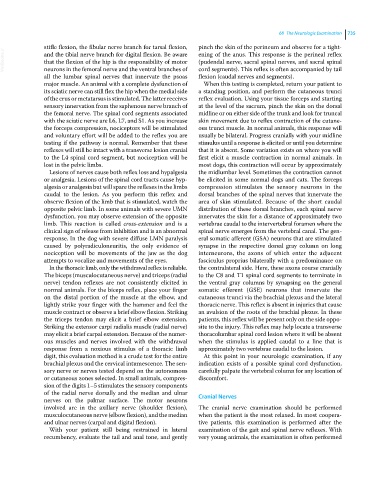Page 767 - Clinical Small Animal Internal Medicine
P. 767
68 The Neurologic Examination 735
stifle flexion, the fibular nerve branch for tarsal flexion, pinch the skin of the perineum and observe for a tight-
VetBooks.ir and the tibial nerve branch for digital flexion. Be aware ening of the anus. This response is the perineal reflex
(pudendal nerve, sacral spinal nerves, and sacral spinal
that the flexion of the hip is the responsibility of motor
neurons in the femoral nerve and the ventral branches of
flexion (caudal nerves and segments).
all the lumbar spinal nerves that innervate the psoas cord segments). This reflex is often accompanied by tail
major muscle. An animal with a complete dysfunction of When this testing is completed, return your patient to
its sciatic nerve can still flex the hip when the medial side a standing position, and perform the cutaneous trunci
of the crus or metatarsus is stimulated. The latter receives reflex evaluation. Using your tissue forceps and starting
sensory innervation from the saphenous nerve branch of at the level of the sacrum, pinch the skin on the dorsal
the femoral nerve. The spinal cord segments associated midline or on either side of the trunk and look for truncal
with the sciatic nerve are L6, L7, and S1. As you increase skin movement due to reflex contraction of the cutane-
the forceps compression, nociceptors will be stimulated ous trunci muscle. In normal animals, this response will
and voluntary effort will be added to the reflex you are usually be bilateral. Progress cranially with your midline
testing if the pathway is normal. Remember that these stimulus until a response is elicited or until you determine
reflexes will still be intact with a transverse lesion cranial that it is absent. Some variation exists on where you will
to the L4 spinal cord segment, but nociception will be first elicit a muscle contraction in normal animals. In
lost in the pelvic limbs. most dogs, this contraction will occur by approximately
Lesions of nerves cause both reflex loss and hypalgesia the midlumbar level. Sometimes the contraction cannot
or analgesia. Lesions of the spinal cord tracts cause hyp- be elicited in some normal dogs and cats. The forceps
algesia or analgesia but will spare the reflexes in the limbs compression stimulates the sensory neurons in the
caudal to the lesion. As you perform this reflex and dorsal branches of the spinal nerves that innervate the
observe flexion of the limb that is stimulated, watch the area of skin stimulated. Because of the short caudal
opposite pelvic limb. In some animals with severe UMN distribution of these dorsal branches, each spinal nerve
dysfunction, you may observe extension of the opposite innervates the skin for a distance of approximately two
limb. This reaction is called cross‐extension and is a vertebrae caudal to the intervertebral foramen where the
clinical sign of release from inhibition and is an abnormal spinal nerve emerges from the vertebral canal. The gen-
response. In the dog with severe diffuse LMN paralysis eral somatic afferent (GSA) neurons that are stimulated
caused by polyradiculoneuritis, the only evidence of synapse in the respective dorsal gray column on long
nociception will be movements of the jaw as the dog interneurons, the axons of which enter the adjacent
attempts to vocalize and movements of the eyes. fasciculus proprius bilaterally with a predominance on
In the thoracic limb, only the withdrawal reflex is reliable. the contralateral side. Here, these axons course cranially
The biceps (musculocutaneous nerve) and triceps (radial to the C8 and T1 spinal cord segments to terminate in
nerve) tendon reflexes are not consistently elicited in the ventral gray columns by synapsing on the general
normal animals. For the biceps reflex, place your finger somatic efferent (GSE) neurons that innervate the
on the distal portion of the muscle at the elbow, and cutaneous trunci via the brachial plexus and the lateral
lightly strike your finger with the hammer and feel the thoracic nerve. This reflex is absent in injuries that cause
muscle contract or observe a brief elbow flexion. Striking an avulsion of the roots of the brachial plexus. In these
the triceps tendon may elicit a brief elbow extension. patients, this reflex will be present only on the side oppo-
Striking the extensor carpi radialis muscle (radial nerve) site to the injury. This reflex may help locate a transverse
may elicit a brief carpal extension. Because of the numer- thoracolumbar spinal cord lesion where it will be absent
ous muscles and nerves involved with the withdrawal when the stimulus is applied caudal to a line that is
response from a noxious stimulus of a thoracic limb approximately two vertebrae caudal to the lesion.
digit, this evaluation method is a crude test for the entire At this point in your neurologic examination, if any
brachial plexus and the cervical intumescence. The sen- indication exists of a possible spinal cord dysfunction,
sory nerve or nerves tested depend on the autonomous carefully palpate the vertebral column for any location of
or cutaneous zones selected. In small animals, compres- discomfort.
sion of the digits 1–5 stimulates the sensory components
of the radial nerve dorsally and the median and ulnar Cranial Nerves
nerves on the palmar surface. The motor neurons
involved are in the axillary nerve (shoulder flexion), The cranial nerve examination should be performed
musculocutaneous nerve (elbow flexion), and the median when the patient is the most relaxed. In most coopera-
and ulnar nerves (carpal and digital flexion). tive patients, this examination is performed after the
With your patient still being restrained in lateral examination of the gait and spinal nerve reflexes. With
recumbency, evaluate the tail and anal tone, and gently very young animals, the examination is often performed

